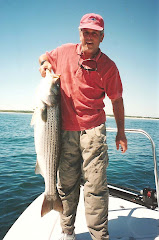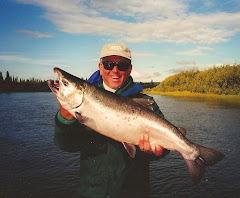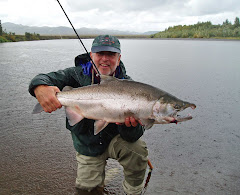Sunday, March 14, 2010
Fundamentals of Fly-Fishing the Surf
If you are interested in exploring the exciting world of saltwater fly fishing you may want to consider joining Angelo Peluso for a unique fly-fishing class. Instruction will take place at selected beach locations where the fundamentals of fly-fishing will be taught in an informal and conversational setting. The basic program is geared toward the new or intermediate fly angler with customized sessions available for more experienced anglers. With almost forty years of fly-fishing experience under his wading belt, Angelo has a wealth of information to share with students attending his classes. Topics covered include: Rod and Reel Selection; Casting; Retrieves; Line Selection; Leaders/Knots; Fly Selection; Essential Gear; Reading Water; Tactical Wading; Elements of Structure; Tactics for local game fish and Beach Safety. Individual and group sessions (up to four participants) are available, and can be structured to meet any specific needs or interests. The full program runs three hours. Specialized hourly classes can also be arranged to meet specific needs, interests or time constraints. Individual instructions as well as small group (4) sessions are available. If you want to cut down the learning curve and quick start your fly-fishing game this may be just the ticket you need to get into ‘fish on the fly’ this season. Angelo’s popular and comprehensive guidebook, Fly Fishing Long Island, is also included as part of the class material. For further information and rates please contact Angelo directly at SaltyFlyLIF@aol.com or visit his website at www.angelopeluso.com.
Saturday, March 6, 2010
Bass Awakening
The show season will soon begin to wind down and the official beginning of spring is but a month away. And then April will bring with it the first signs of striped bass being caught off the jersey Shore, J-Bay, Island’s west end, Little Neck Bay and many of the shallow back-water areas that awaken to the Spring’s warming sun. Increasing bass activity will also take place in many of the more predominant fresh water rivers around the tri-state area: Delaware River, Hudson River, Connecticut, Thames and Housatonic Rivers. So, it’s never too early to prepare for the seasonal renaissance and return of stripers.
Most of the bass that visit Long Island waters originate from either the Chesapeake River or Hudson River stocks. Stripers are classified as anadromous, meaning they live predominantly in saltwater but return from the salt to their natal freshwater rivers to spawn. Once the spawning mandate is satisfied the bass move out of those rivers and begin to move back to saltwater. They will infiltrate the inland waters and move up the Northeast coast. Starting in about mid-April bass will begin to be caught in the western most parts of Long Island and as the season progresses gradually flood into all areas around Long Island. Many will take up residence in the waters surrounding Long Island, including numerous bays and harbors, while many bass will continue their journey right up the entire length of the coast. During the fall migration huge masses of both bait and pursuing striped bass will move south to their wintering areas. When this movement occurs it seems as if every bass in the world passes through the toll gates at the east end of the Island, most notably Montauk at the tip end of the South Shore and Orient Point and the Race off the Island’s North Fork. Striped bass are essentially an inshore fish and as such provide numerous angling opportunities for near shore fly and light tackle anglers. Stripers show a marked preference for boulders, rocks…as one of its nicknames, “rockfish” implies… jetties, pilings, docks, piers, riprap and other forms of visible or submerged structure. They can also be caught in open water as well as on sand and gravel flats in literally inches of water. It may come as a surprise to some but sizable flats exist on Long Island and a growing number of fly fishermen and light tackle anglers are pursuing them in that venue. It is a sight fishing phenomenon comparable in many respects to tropical bone fishing and casting to tailing redfish in Florida.
Most of the bass that visit Long Island waters originate from either the Chesapeake River or Hudson River stocks. Stripers are classified as anadromous, meaning they live predominantly in saltwater but return from the salt to their natal freshwater rivers to spawn. Once the spawning mandate is satisfied the bass move out of those rivers and begin to move back to saltwater. They will infiltrate the inland waters and move up the Northeast coast. Starting in about mid-April bass will begin to be caught in the western most parts of Long Island and as the season progresses gradually flood into all areas around Long Island. Many will take up residence in the waters surrounding Long Island, including numerous bays and harbors, while many bass will continue their journey right up the entire length of the coast. During the fall migration huge masses of both bait and pursuing striped bass will move south to their wintering areas. When this movement occurs it seems as if every bass in the world passes through the toll gates at the east end of the Island, most notably Montauk at the tip end of the South Shore and Orient Point and the Race off the Island’s North Fork. Striped bass are essentially an inshore fish and as such provide numerous angling opportunities for near shore fly and light tackle anglers. Stripers show a marked preference for boulders, rocks…as one of its nicknames, “rockfish” implies… jetties, pilings, docks, piers, riprap and other forms of visible or submerged structure. They can also be caught in open water as well as on sand and gravel flats in literally inches of water. It may come as a surprise to some but sizable flats exist on Long Island and a growing number of fly fishermen and light tackle anglers are pursuing them in that venue. It is a sight fishing phenomenon comparable in many respects to tropical bone fishing and casting to tailing redfish in Florida.
Subscribe to:
Comments (Atom)

















